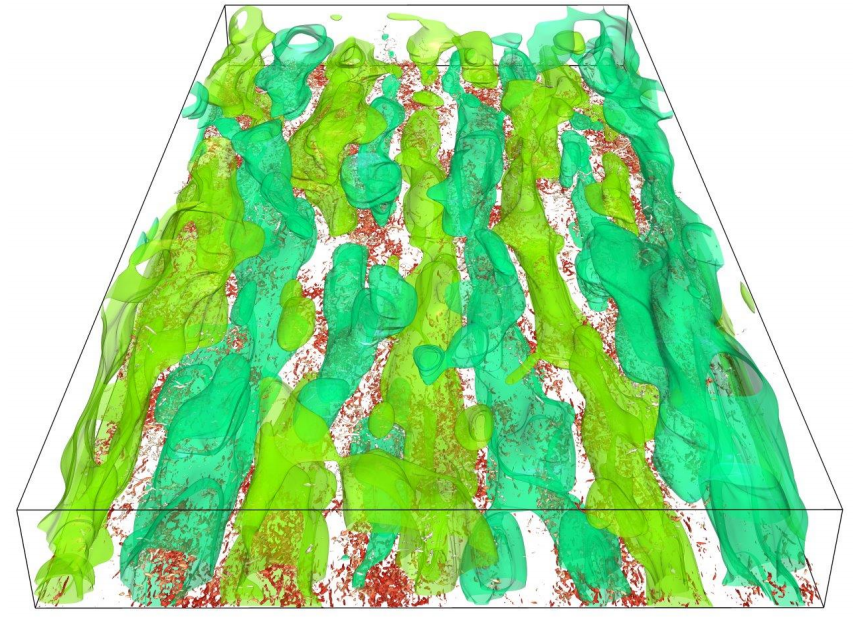How do turbulent superstructures interact with skin friction drag?
- contact:
- funding:
- Partner:
- startdate:
Second phase: 2020
First phase: 2016 - 2019
The Institute of Fluid Mechanics (ISTM) is part of the DFG Priority Programme 1881 titled "Turbulent Superstructures", which aims at understanding how superstructures - flow features that have a typical size comparable to the largest lengthscale of the flow - affect the dynamics of different turbulent flows. A detailed description of the scope and goals of the DFG Priority Programme 1881 can be found here: https://www.tu-ilmenau.de/turbspp/ .

Phase 2
Turbulent Superstructures (TSS), large connected regions of relatively low or high velocity, are known to cause strong large-scale velocity fluctuations and have been recognized to play an important role in the dynamics of turbulent flows.
In a similar fashion, flows with secondary motions of Prandtl’s second kind, e.g. generated by spanwise inhomogeneous surfaces, provide a flow scenario with the
simultaneous presence and interactions of large and small scales at moderate Reynolds numbers. The generated flow resembles TSS in respect to scale interactions, enabling to study this scale interaction phenomena which is otherwise difficult to assess. The secondary motion can thus serve as a model system for TSS that occur over smooth surfaces in higher Reynolds number flows.

Figure: Time averaged streamwise velocity U obtained from hot-wire experiments at Re_b = 18000 . The strong bulges in the mean streamwise velocity are a direct result of the secondary motion. Intersection of dashed lines indicate the measurement grid.
In the present study, the influence of large scale flow structures on the near wall region, i.e the wall shear stress will be investigated. Channel flow configurations exposed to spanwise surface heterogenities generating large-scale secondary motions, as shown in the figure below, will be studied both numerically and experimentally.
The aim is to understand how TSS contribute to skin friction drag through detailed analysis of the momentum exchange between the fluid and the wall, interpreting the related scale interaction and their Reynolds number dependence.
Associated member: Kay Schäfer
Second SPP-project at ISTM: Interactions between superstructures and other scales of turbulent flows by Davide Gatti
Phase 1
Within the Priority Programme our institute focuses on understanding the role of superstructures in generating skin-friction drag and to study the opportunity to control them.
In turbulent wall-bounded flows at increasing values of the Reynolds number, the size of the near-wall region, in which an important autonomous mechanism of turbulence self-sustainment occurs, shrinks, while a hierarchy of turbulent structures with increasing size appears. These structures are termed turbulent superstructures and, even though they have been frequently observed as extremely largescaled velocity fluctuations or vortex clusters, their impact on turbulent mixing processes and, in
particular, on momentum transfer is still unknown. In the present project we aim at understanding the role of turbulent superstructures in momentum transport towards the wall, with particular focus on their impact onto turbulent skin friction drag. Our investigation relies on high-fidelity direct numerical simulation of turbulent incompressible channels and boundary layer flows at high values of the Reynolds number. In order to study the mutual interaction of turbulent superstructures with skin-friction drag and near-wall turbulence, we will observe how superstructures react to modification of the flow natural state by applying directly at the wall or in its vicinity turbulent flow control strategies, which are capable of reducing turbulent drag. The contribution of turbulent superstructures to skin friction drag is quantified by estimating their scale contribution to the Reynolds shear stress. Several strategies to identify turbulent coherent structures will aid us in providing a kinematic description, which is compatible with their footprint on turbulent statistics. Finally, we analyse whether flow manipulation
explicitly targeting superstructures is an attractive means for skin friction drag reduction at large values of the Reynolds numbers.

In the figure above you see the smallest (red isosurfaces) and largest (green isosurfaces) structures in a turbulent channel at friction Reynodls number of 1000. The former have been visualized as isosurfaces of a vortex identification criterion and the latter as large-scale positive and negative velocity fluctuation, identified within the flow via Empirical Mode Decomposition.
